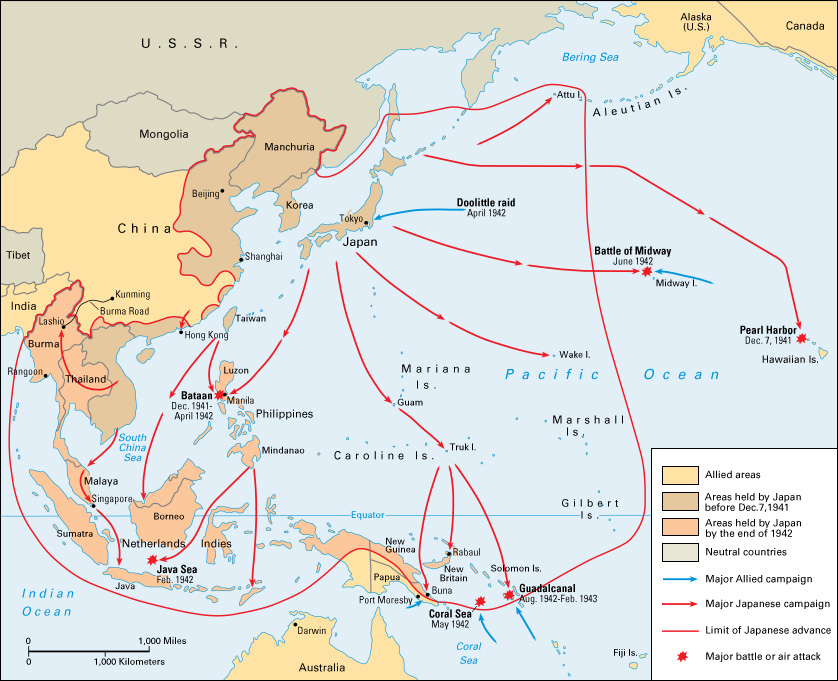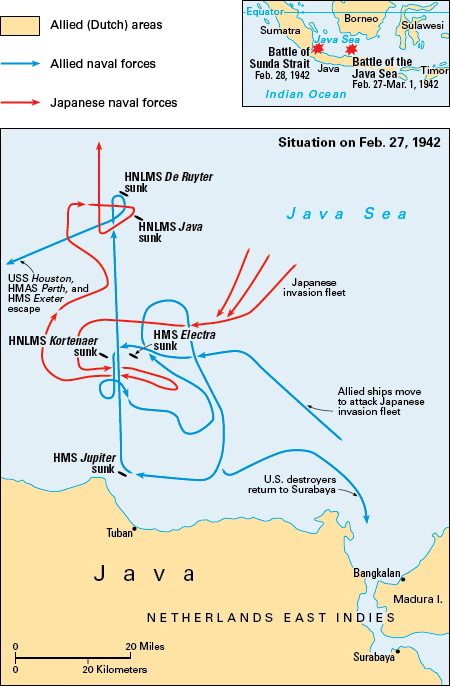Java Sea, Battle of the, was fought between Japanese and Allied naval forces during World War II (1939-1945). The Allied side included forces from the United Kingdom, the Netherlands, the United States, and Australia. The battle took place from February 27 to March 1, 1942, and ended in a decisive Japanese victory. The destruction of the Allied force allowed for Japan’s conquest of the Netherlands East Indies (present-day Indonesia). The Java Sea, part of the far western Pacific Ocean, is a shallow sea at the center of the Indonesian island group.
Background.
On Dec. 7, 1941, Japan attacked the U.S. naval base at Pearl Harbor, Hawaii. The United States, Australia, the Netherlands, and the United Kingdom declared war on Japan the next day. From December 1941 to February 1942, the Japanese swept through Thailand and routed Allied forces on the Malay Peninsula. Japan then attacked the petroleum-rich Netherlands East Indies. They landed troops on the Dutch islands of Bali, Borneo, Sulawesi, and Sumatra. In late February, a Japanese invasion force headed for the island of Java. The Japanese force included dozens of troop transports, 4 cruisers, 14 destroyers, and a number of warplanes.

A combined Allied force of British, Dutch, American, and Australian warships approached the Japanese in the Java Sea. The Allied naval force, however, was hastily assembled and poorly coordinated. It had 5 cruisers and 11 destroyers, and few of the ships were modern.
The battle.
On Feb. 27, 1942, the Allied ships attacked the Japanese invasion fleet. Superior ships and tactics quickly turned the battle in Japan’s favor. Japanese gunners scored hits on three Allied cruisers. Torpedo attacks by Japanese cruisers sank the Dutch destroyer Kortenaer and the Dutch cruisers De Ruyter and Java. The British destroyer Jupiter struck a mine and sank. Japanese guns sank the British destroyer Electra.

Japanese troops began landing on the island of Java on February 28. The sea battle continued that night, as the Japanese sank the American cruiser Houston, the Australian cruiser Perth, and the Dutch destroyer Evertsen. This engagement, fought off Java’s west coast, is sometimes called the Battle of Sunda Strait.
On March 1, the Japanese sank the British warships Encounter and Exeter and the American destroyer Pope. This last action is sometimes called the Second Battle of the Java Sea. Four American destroyers escaped to Australia.
Aftermath.
The Allies lost 11 ships and more than 2,000 sailors in the Battle of the Java Sea. Hundreds of sailors became prisoners of war. The Japanese lost four troop transports. Allied forces on Java surrendered on March 9. The Japanese occupation of the Netherlands East Indies ended with Japan’s surrender in August 1945.
See also Indonesia (Independence) ; World War II (Early Japanese victories) .
